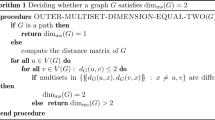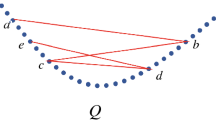Abstract
Let [n] = {1, 2, …, n}. Suppose we have k linear orderings on [n], say <1, <2, …, <k. Let M ⊆ [n]. Then M has a minimum for each linear ordering <i. So M has at most k minima. A set M ⊆ [n] is called a 2min-set if it has at most two different minima in the linear orderings <1, <2, …, <k. Similarly, a set N ⊆ [n] can have at most k minima and k maxima for any k linear orderings. A set N ⊆ [n] is called a 2minmax-set if there exist a, b ∈ N such that all the elements in N | {a, b} lie in between a and b for every linear ordering <i. In this paper, we shall determine the sizes of 2min-sets and 2minmax-sets for certain k linear orderings.
Access this article
We’re sorry, something doesn't seem to be working properly.
Please try refreshing the page. If that doesn't work, please contact support so we can address the problem.
Similar content being viewed by others
References
I. Bárány and J. Lehel, Covering with Euclidean boxes, European J. Combin., 8 (1987), 113–119.
P. J. Cameron, Permutation groups, London Math. Soc. Student Texts 45, London. Math. Soc., 1999.
V. Grolmusz, On a Ramsey-theoretic property of orders, J. Combin. Theory Ser. A, 61 (1992), 243–251.
Y. Ishigami, Containment problems in high-dimensional spaces, Graphs Combin., 11 (1995), 327–335.
C. Y. Ku and K. B. Wong, The group marriage problem, J. Combin. Theory Ser. A, 118 (2011), 672–680.
Author information
Authors and Affiliations
Corresponding author
Additional information
Communicated by Imre Bárány
Rights and permissions
About this article
Cite this article
Wong, K.B. On 2min-sets and 2minmax-sets with respect to certain cycles. Period Math Hung 67, 133–142 (2013). https://doi.org/10.1007/s10998-013-6670-1
Received:
Accepted:
Published:
Issue Date:
DOI: https://doi.org/10.1007/s10998-013-6670-1




